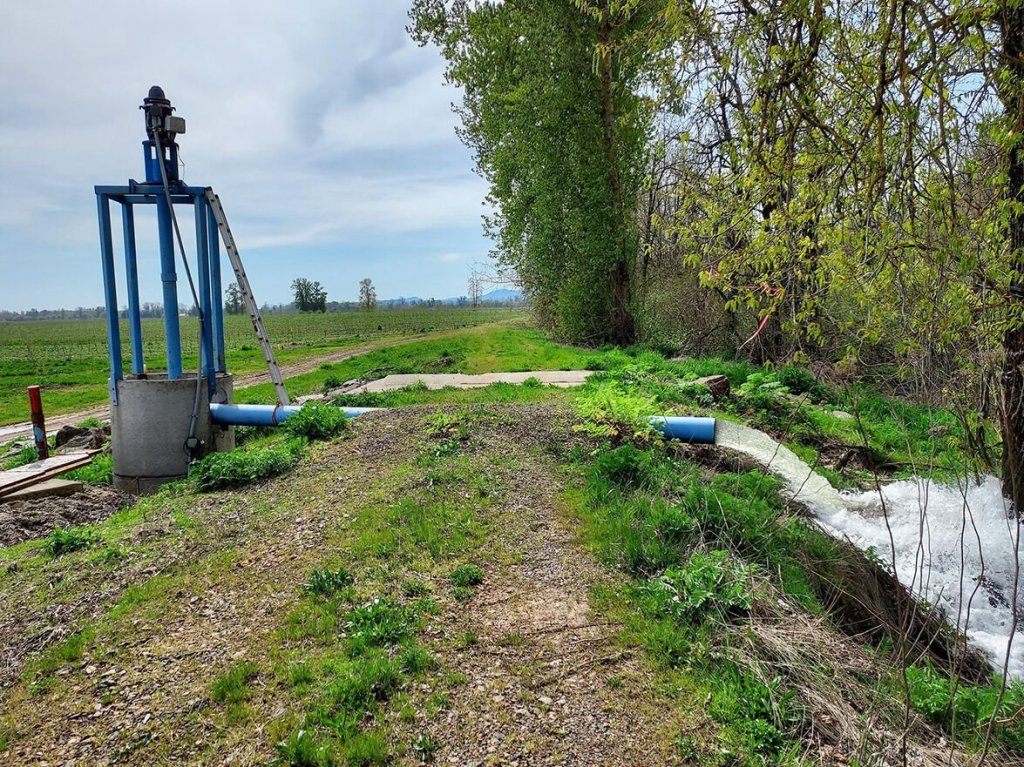Assessment outlines farmers’ needs to combat heat, drought
Published 5:00 am Saturday, August 5, 2023

- A sump pumps excess water from a strawberry and hazelnut farm near Salem.
CORVALLIS — Oregon farmers and ranchers are already largely aware of what management practices and tools are available to help them withstand extreme heat and drought, according to a recently published statewide needs assessment.
Trending
What producers say they want from policymakers is more funding and technical assistance to put those resources in place.
Legislators requested the assessment in 2021 as part of a $100 million emergency relief package on the heels of that year’s prolonged “heat dome,” which brought triple-digit temperatures to the Northwest.
The brutal heat scorched crops and was compounded by lingering drought, leaving farms in some areas without enough water to make it through the summer.
Trending
Berit Dinsdale, a postdoctoral scholar at Oregon State University, led the outreach. She interviewed 59 producers from across the state, asking what they are doing to improve drought and heat resiliency and what additional support they would like to see in the future.
A final report was submitted to the Legislature in June. It is also posted publicly online at shorturl.at/fqtBK.
“Many of the issues that people are facing are very local,” Dinsdale said. “But that being said, there are some general things that were true across the board, regardless of region. We think those pieces in particular could be very useful.”
Irrigation systems
For the most part, participants said they were already using the most water-efficient irrigation systems for their operations — such as drip, micro sprinklers or low-elevation sprayers.
Cost was the biggest hurdle for producers considering new equipment. While there are federal rebate and cost-sharing programs to assist farmers and ranchers, those interviewed said the application process can be long and confusing.
Dinsdale said producers need greater access to specialists who can help them find, navigate and apply for funding more quickly.
“Time is of the essence in farming and ranching,” she said. “Producers really need timely assistance.”
Water storage is another valuable tool, according to the assessment, though Dinsdale said the farmers and ranchers she talked to were not always clear about the rules for building on-site ponds, tanks and reservoirs.
Soil management
Much like irrigation systems, Dinsdale said producers of soil management practices can help their land retain more water and organic matter.
“Cover cropping is very useful for maintaining soil health,” she said. “No-till or reduced till … a lot of people are already using these strategies where applicable.”
But no-till farming equipment is expensive, and a lack of water during drought means growing a cover crop is not always possible. As for ranchers, the cost of fencing is a barrier to adopting rotational grazing for livestock.
The assessment calls for expanding grants to cover fencing for rotational grazing. It also suggests the state could work with partner agencies, including soil and water conservation districts, to purchase no-till equipment that can be loaned to producers.
Data interpretation
Increased funding is one thing, but Dinsdale said producers need people who can help them interpret data and make the right decisions for their farm or ranch.
“We live in an era of data glut,” she said. “What do you do with all of it?”
Organizations such as OSU Extension Service are part of the solution, processing and interpreting data for individual producers. The assessment calls for the state to invest more in this work, along with more precise weather and precipitation modeling.
“It goes back to that question of time and energy,” Dinsdale said. “You have so many things you’re thinking about (as a farmer). Having someone say here’s what your data looks like, here’s what that means and here’s some actionable items for you (would be beneficial).”
Switching commodities
In some cases, Dinsdale said producers might need to reduce acreage or switch to less water-intensive crops in order to make ends meet.
Making a change can be risky. The assessment outlines several potential solutions, including new subsidies or grants to help producers transition to more drought- and heat-resistant crops; increase research on new crop varieties; and trials for alternative farming methods such as dry farming.
For producers to take on something new, Dinsdale said seeing is believing. That’s where researchers can make a difference.
“It also really creates better relationships between institutions like OSU and producers,” she said.
What’s next
The assessment does not propose any specific policies or funding. Rather, Dinsdale said she hopes it will help lawmakers better understand what obstacles farmers and ranchers are facing from heat and drought.
“You can’t pull water out of thin air, but you can help people get access to the resources they need,” Dinsdale said.
Researchers at Oregon State University Extension Service interviewed 59 farmers and ranchers across the state asking what they need to better weather extreme heat and drought.
Of those interviewed:
• 16 are from Central Oregon.
• 4 are from the Oregon Coast.
• 5 are from Eastern Oregon.
• 8 are from the northern Willamette Valley (including Clackamas, Multnomah and Washington counties).
• 13 are from Southern Oregon.
• 13 are from Western Oregon (including Benton, Lane, Linn, Marion, Polk and Yamhill counties).
Size of operations also varied from large to small, including:
• 26 with 0-99 acres.
• 9 with 100-499 acres.
• 5 with 500-999 acres.
• 19 with 1,000 or more acres.
Most farms and ranches that participated are diversified, growing multiple crops and livestock. The breakdown of commodities includes:
• 31% livestock, dairy, pasture forage.
• 17% field crops.
• 14% tree fruit, nuts, berries.
• 13% vegetables.
• 12% floriculture, nursery, sod.
• 11% seed crops.
• 2% winegrapes.









